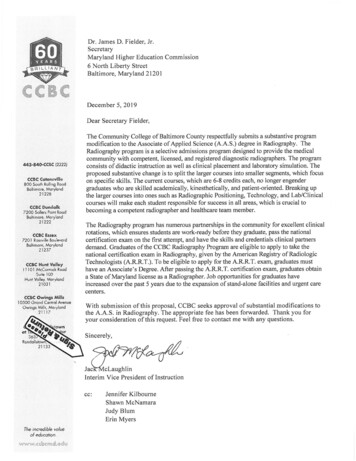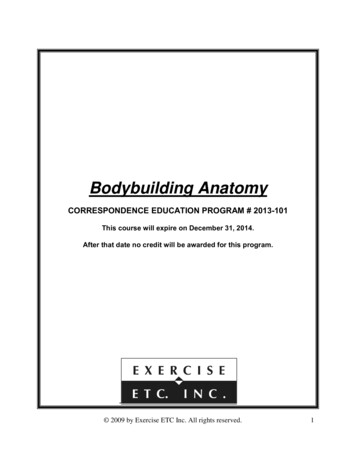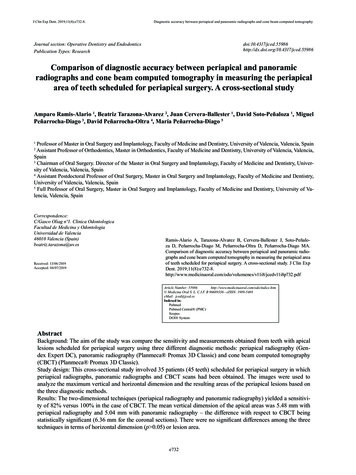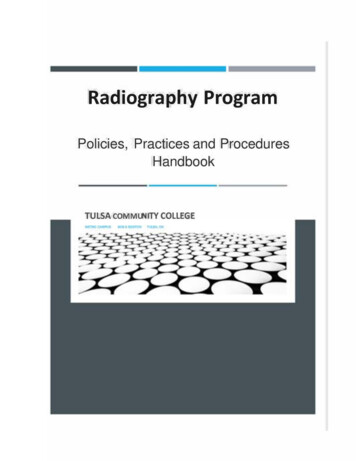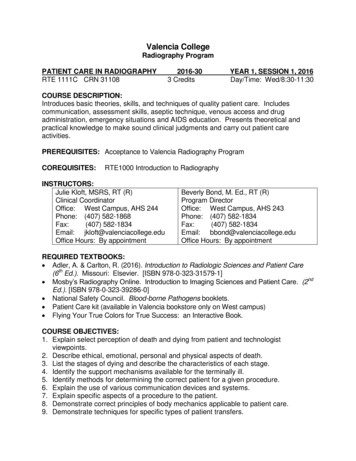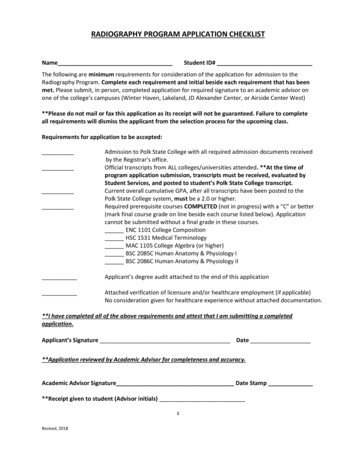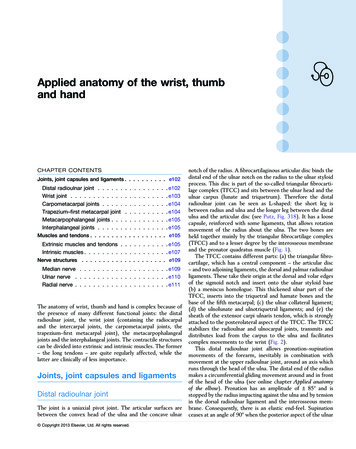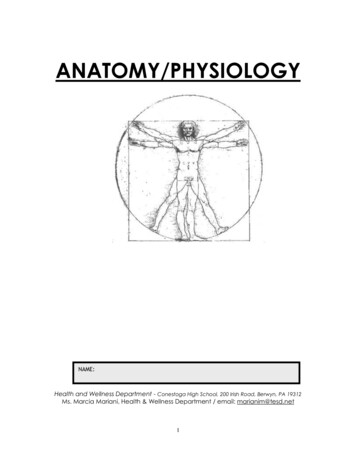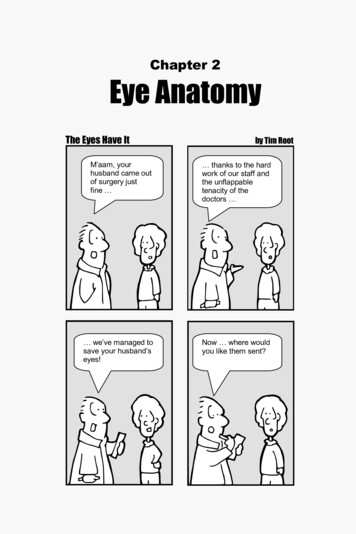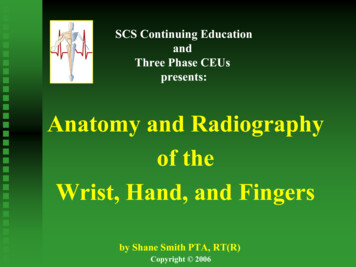
Transcription
SCS Continuing EducationandThree Phase CEUspresents:Anatomy and Radiographyof theWrist, Hand, and Fingersby Shane Smith PTA, RT(R)Copyright 2006
Introduction:Hello and welcome to this program from SCS ContinuingEducation! Knowledge is the key to success for ourselves andEducationour patients. This easy-to-use point and click program allowsyou to navigate through text and visual aides designed toprovide a comprehensive view of the material covered. Pleasefeel free to contact Shane Smith at ceuarmy@yahoo.com if youhave any questions.Course Abstract and Objectives:The objective of this home study course is to provide thelearner with a computer based tutorial that will give them themeans to learn the anatomy and radiography of the wrist,hand and fingers. A mastery test will be administered at theend of this home study course in order to ensure thatcompetency of the material has been achieved.All images and artwork used in this program were obtained or drawn by Shane Smith.
Anatomy and Radiography of theWrist, Hand and Fingersby Shane Smith PTA, RT(R)Copyright 2006
CHAPTERS: Fundamentals of the Wrist and HandHand. pg 5Bony AnatomyAnatomy . pg 8Positioning pg 15PositioningTechnical GuidelinesGuidelines .pg 30MRI . pg 32MRICommon Clinical FindingsFindings . pg 39Conclusiononclusion pg 48Test . pg 49TestReferences pg 50References
Fundamentals of theWrist and Hand
Fundamentals of the Wrist and Hand:In a rested position, the palm of the hand is concave. The thumb is located90 to the fingers and is of particular importance to the dexterity of the hand.Functional position of the wrist and hand has been determined to be: wrist complex: 20 extension and 10 ulnar deviation MCP joint: 45 flexion PIP joint: 30 flexion DIP joint: slight flexionLet’s review the type of joints involved in the wrist and hand:1.ellipsoid (ovoid) joint: oval surface of one bone fits into an elliptical cavity ofanother; biaxial, typically flexion/extension and abduction/adduction.2.gliding joint: side to side or front to back slipping between nearly flat bones.3.hinge joint: monaxial; flexion/extension.4.saddle joint: biaxial; both bones contain concave and convex portions.5.synovial joint: diathrotic; allows one or more types of free movement; containarticular cartilage, synovial fluid, synovial membrane and afibrous capsule.
Fundamentals of the Wrist and Hand:JointBones involvedTyperadiocarpal (wrist)radius and carpalssynovial; ellipsoidintercarpaladjacent carpalssynovial; glidingcarpometacarpalcarpals and metacarpals(digits 2-5)carpometacarpaltrapezium and 1st metacarpal(thumb)metacarpophalangeal metacarpal and proximalphalanxinterphalangealadjacent phalangessynovial; glidingsynovial; saddlesynovial; glidingsynovial; hingeinterphalangeal jointmetacarpophalangeal jointintercarpal jointcarpometacarpal jointradiocarpal joint
Bony Anatomy
Bony Anatomy:Let’s begin by reviewing the bones of the right wrist inanatomical position:Distal Row:1. Hamate (unciform)2. Capitate ( os magnum)3. Trapezoid (lesser multangular)4. Trapezium (greater multangular)15627348Proximal Row:5. Pisiform6. Triquetral (triquetrum)7. Lunate (semilunar)8. Scaphoid (navicular)ulnaradiusNote: the ulna is not considered part of the wrist complexand is named for identification purposes only.
Bony Anatomy:Let’s identify the bones of this PA view of the right wrist:wrist:Distal Row:1. Hamate (unciform)2. Capitate ( os magnum)3. Trapezoid (lesser multangular)4. Trapezium (greater multangular)Proximal Row:5. Pisiform6. Triquetral (triquetrum)7. Lunate (semilunar)8. Scaphoid (navicular)431256857RadiusUlnarNote: The PA wrist is obtained when the patient’s hand isin a palm down position. This is not anatomical position
Bony Anatomy:Now let’s review the bones of theright hand in anatomical re are 5 metacarpals inproximalphalanxthe hand.Phalanges:Digits 2-5 have a proximal,4 3 2middle and distal phalanx.5The thumb (pollicis(pollicis)) doesnot consist of a middlemetacarpalsphalanx, however, it doeshave two sesamoid bones. Both the Metacarpal andPhalanx have articulatingsurfaces; the head distallyand the base proximally.phalangeshead1basesesamoidbones
Bony Anatomy:Let’s review the bones of the lefthand xx-ray in this PA position:Metacarpals:There are 5 metacarpals inthe hand.Phalanges:Digits 2-5 have a proximal,middle and distal phalanx.The thumb (pollicis(pollicis)) doesnot consist of a middlephalanx, however, it doeshave two sesamoid bones. Both the Metacarpal andPhalanx have articulatingsurfaces; the head distallyand the base nx5phalanges4 3metacarpalshead21basesesamoidbones
Bony Anatomy:Let’s take a closer look at the hand/fingers. The diagram below of thefingers of the right hand in anatomical position identifies the al jointProximalInterphalangeal metacarpaljoint
Bony Anatomy:The xx-ray below of the fingers of the left hand in a PA position identifiesthe joints.DIPjointPIPjointbaseheadMCPjointCMCjoint
Positioning
Positioning: General Guidelines: remove any jewelry that will interfere with the anatomy beingradiographed. make patient as comfortable as possible; some positions that the patientmust conform to and maintain in order for a diagnostic image to beobtained can be difficult due to disease process, trauma, etc. It is importantto keep that in mind when positioning patients for an exam. always shield when possible; for the purpose of this program, shieldingshould always be utilized for radiography of the wrist and hand. use collimation; at minimum, collimation should not exceed thecassette size. the body part should be parallel to the film; the central ray (centering)should be perpendicular (90 ) to the body part and the film. Lead markers should be used to identify RIGHT or LEFT.
Positioning: PA wrist: Place hand and wrist onto the cassette palm down. Center at the midcarpal area of the wrist. Include the distal radius and ulna, carpals and ½ of themetacarpals.
Positioning: PA Oblique wrist: Place hand and wrist onto the cassette at a 45 angle. Center at the midcarpal area of the wrist. Include the distal radius and ulna, carpals and ½ of themetacarpals.
Positioning: Lateral wrist: Place the wrist onto the cassette in a lateral (thumbup) position. Center at the midcarpal area of the wrist. Include the distal radius and ulna, carpals and ½ of themetacarpals.
Positioning: PA Navicular: Place hand onto the cassette palm down with wrist inulnar deviation (flexion toward ulnar side). Angle tube 10 - 15 toward the elbow. Center at the navicular (scaphoid). Include the distal radius and ulna, carpals and proximalmetacarpals.
Positioning: PA hand: Place pronated hand (palm down) onto the cassette. Center at the 3rd MP joint. Include the entire hand and distal radius and ulna.
Positioning: PA Oblique hand: Place pronated hand onto the cassette at a 45 angle. Center at the 3rd MP joint. Include the entire hand and distal radius and ulna.
Positioning: Lateral hand: If possible, place hand in a “fan” lateral position(recommended) onto the cassette. Center at the 2nd MP joint. Include the entire hand and distal radius and ulna.
Positioning: PA finger: Place hand palm down onto the cassette. Center to the PIP joint. Include the entire finger and distal third of metacarpal.
Positioning: PA Oblique finger: Place hand, palm facing down, onto the cassette at a45 angle. Center at the PIP joint. Include the entire finger and distal third of metacarpal.
Positioning: Lateral finger: A mediolateral projection is utilized for the 2nd finger. Place finger onto the cassette from a thumb-down lateralposition. A lateromedial projection is utilized for the 3rd, 4th and5th fingers. Place finger parallel to the cassette from a thumb-up lateralposition. Center to the PIP joint. Include the entire finger and MCP joint.
Positioning: AP thumb: Internally rotate hand until the back of the thumb canbe placed onto the cassette. Center at the 1st MP joint. Include the entire thumb, CMC joint and trapezium.
Positioning: PA Oblique thumb: Place hand palm down onto the cassette. Center at the 1st MP joint. Include the entire thumb, CMC joint and trapezium.
Positioning: Lateral thumb: Curl fingers and place hand onto the cassette. Center at the 1st MP joint. Include the entire thumb, CMC joint and trapezium.
TechnicalGuidelines
Technical Guidelines: Radiography of the hand and wrist is done at a 40 inch SID (sourceimage distance). Keep the body part as close to the cassette as possible in order toreduce OID (object image distance). Radiographs of the wrist and hand are of better diagnostic qualitywhen an extremity cassette is utilized. CR (computerized radiography)does not use conventional cassettes or film. Instead, a digitized plate isutilized which can be programmed to act like an extremity cassette. Thedifference is, however, that it is advised to only put one image percassette. Multiple images on one cassette do not always appear properlyand are difficult to “window” correctly. Although x-ray machines vary, the general kVp ranges for radiographyof the wrist and hand is between 50-65 kVp. Adjustments in kVp and MAs should be considered in cases involvingsplints, casts, wraps, swelling, braces, etc.
MRI
MRI: OverviewA comprehensive explanation of MRI physics is outside thescope of this program but in order to appreciate thefollowing slides and gain the most value from them, asimplistic overview is provided.Magnetic Resonance Imaging (MRI) is an imaging processthat utilizes a magnetic field to magnetize tissues of the bodyin order to create a radio frequency signal (RF) that will, withthe assistance of coils and a computer, produce an image.The magnetic field primarily affects tissues with anadequate amount of hydrogen. A high concentration ofhydrogen will produce a strong signal and a bright areaon the image while a low concentration will producelittle or no signal. No signal will produce a black areawith the signals in between producing gray areas,contrast.
MRI: Tissue Characteristics and Contrast:One advantage to MRI is the ability to utilize the variety oftissues in the body to produce contrast. The tissues of the bodyare divided into three characteristics: T1, PD and T2. Imagesproduced in MRI are often described as being T1, PD or T2“weighted.” Let’s use the diagram below to help define theseterms as they relate to the image that is produced.T1: on a T1 weighted image, fat is bright and water is dark.PD: on a proton density image, water is bright and fat isdark but the contrast between the two is less define.T2: on a T2 weighted image, water is bright and fat is darkbut the contrast is greater.brightPDfatwaterT1T2waterT1fatPDdarkT2
MRI: Coronal T2The coronal view ofthe wrist in MRI iscomparable to the PAview of the wrist inx-ray. The image tothe right is one slice ofa coronal zoidcapitatenavicularradius
MRI: Sagittal T1The sagittal view ofthe wrist in MRI iscomparable to thelateral view of thewrist in x-ray. Theimage to the right isone slice of a ateradiusmetacarpalcapitateextensordigitorumtendon
MRI: Axial PD T2trapeziumThe axial view of thewrist in MRI has nocomparable view in xray. The axial slice issimilar to slices in aloaf of bread. Theimage to the right isone slice of an axialsequence through thedistal carpal siformhook of hamate
MRI: Axial T2extensor carpiradialis longustendonThe axial view of thewrist in MRI has nocomparable view in xray. The axial slice issimilar to slices in aloaf of bread. Theimage to the right isone slice of an axialsequence through theproximal carpal row.extendor carpiradialis brevistendonlunatenavicularflexor carpiradialis tendonflexor ndonstriquetrumextendor carpiulnaris tendonflexor digitorumprofunus tendons
Common ClinicalFindings
Common Clinical Findings:Now that we’ve reviewed and understand the basic structure of the wristand hand, let’s review some of the common clinical findings.1. Colles’ Fracture- a fall on an outstretched hand produces a supinating force on thewrist as the forearm pronates under the weight of the body; resultsin a transverse fracture of the distal radius with a displacement ofthe hand backward and outward; this combination produces adinner fork deformity- Rx: ice (swelling), splint, cast (closed reduction) or pins (externalfixation)2. Dupuytren’s Contracture-a painless thickening and contracture of the palmar fascia due to fibrousproliferation; results in flexion deformities of the finger(s) into the palmwith loss of function (extension) of the finger(s) involved; associatedwith liver disease and long term use of phenytoin-Rx: surgery
Common Clinical Findings:3. Carpal Tunnel Syndrome-compression of the median nerve between the flexor tendons and thetransverse carpal ligament; primarily found in patients with history ofprolonged (repetitive) manual work with hands (specifically wristflexion) which puts pressure on the flexor retinaculum; results in painand/or numbness which may radiate up arm-Phalen’s Test: hold wrist hyperflexion x 1 minute; positive test ifsensation changes result-Tinel’s Sign: tap flexor retinaculum; results in tingling sensationif median nerve is compressed-Rx: rest, temporary splinting, surgery, NSAIDs, iontophoresis, ice, heat
Common Clinical Findings:4. Swan Neck Deformity-hyperextension of the PIP joint and flexion of the DIP joint as a result ofdamage (frequently from rheumatoid arthritis) that causes hypermobilityof the PIP joints and a migration of the lateral bands dorsally; results ina loss of the normal balance of forces around the PIP joint; may result ininterossei muscles to become taunt5. Boutonniere Deformity (“button hole”)-contracture of hand musculature which results in flexion of the PIP jointand hyperextension of the the DIP joint; results in a decrease of extensorpower at the DIP joint
Common Clinical Findings:6. Arthritic Changes-Osteoarthritis: degeneration of articular cartilage so that the bony endstouch; friction between the bones worsens the condition; slow,symmetrical development of stiffness with minimal pain unless it isassociated with trauma; usually associated with varus deformity in theIP joints distal to proximal-Rheumatoid Arthritis: an autoimmune disease in which the immunesystem attacks its own cartilage and joint linings; usually occurs bilaterally; painful decreases in motion with varying degrees of inflammation;results in ulnar drift of fingers, crepitus and ankylosis (immobility of ajoint) in wrist flexion7. Boxer’s fracture-fracture of the head of the 5th metacarpal.
Common Clinical Findings:fracture baseof 5thmetacarpal
Common Clinical Findings:Oblique hand with pinsfracture baseof 1stmetacarpalLateral hand with pins and cast
Common Clinical Findings:Boxer’s fractureBoxer’s fracture
Common Clinical Findings:foreign bodynail in soft tissueof thumb
Conclusion: Radiography of the hand , fingers and wrist is done at a 40 inch SID(source image distance). Keep the body part as close to the cassette as possible in order toreduce OID (object image distance). Although x-ray machines vary, the general kVp ranges for radiographyof the wrist and hand is between 50-65 kVp. Adjustments in kVp and MAs should be considered in cases involvingsplints, casts, wraps, swelling, braces, etc. The body part should be parallel to the film and the central ray(centering) should be perpendicular (90 ) to the body part and the filmunless otherwise indicated. Always shield when possible; use collimation, identify LEFT orRIGHT by utilizing lead markers, remove jewelry that may interferewith anatomy and be conscious of patient comfort when positioning.
Test:There are 60 questions on this test. All answers can befound within the context of this program. The “hint”button located next to each question will provide youthe information needed to answer the question. At anytime during the test you may skip a question and returnto it later. You must successfully answer 70% of thequestions in order to receive credit for the course. Toaccess the test, please close out of this course byclicking the “x” in the top right corner.Good luck!!!
References:Norkin, Cynthia C. and Levangie, Pamela K.; Joint Structure & Function: AComprehensive Analysis, Second Edition, F.A. Davis Co. Philadelphia, PA. 1992Hislop, Helen J. and Montgomery, Jacqueline; Daniels and Worthingham’s MuscleTesting: Techniques of Manual Examination, Sixth Edition, W.B. Saunders Co.Philadelphia, PA. 1995Stalheim-Smith, Ann and Fitch, Greg K.; Understanding Human Anatomy andPhysiology, West Publishing Co. St. Paul, MN. 1993Thomas, Clayton L.; Taber’s Cyclopedic Medical Dictionary, Seventeenth Edition,F.A. Davis Co. Philadelphia, PA. 1993Bontrager, Kenneth L.: Textbook of Radiographic Positioning and Related Anatomy,Fourth Edition, Mosby Inc. St. Louis, MO. 1997Tortora, Gerard J. and Grabowski, Sandra R.; Principles of Anatomy and Physiology,Ninth Edition, John Wiley & Sons, Inc New York, NY. 2000Stoller, David W.; Magnetic Resonance Imaging in Orthopaedics and Sports Medicine,J.B. Lippincott Co. Philadelphia, PA. 1993Sprawls, Perry; Magnetic Resonance Imaging Principles, Methods, and Techniques,Medical Physics Publishing, Madison, WI. 2000
Positioning: Lateral finger: A mediolateral projection is utilized for the 2nd finger. Place finger onto the cassette from a thumb-down lateral position. A lateromedial projection is utilized for the 3rd, 4th and 5th fingers. Place finger parallel to the cassette fr
